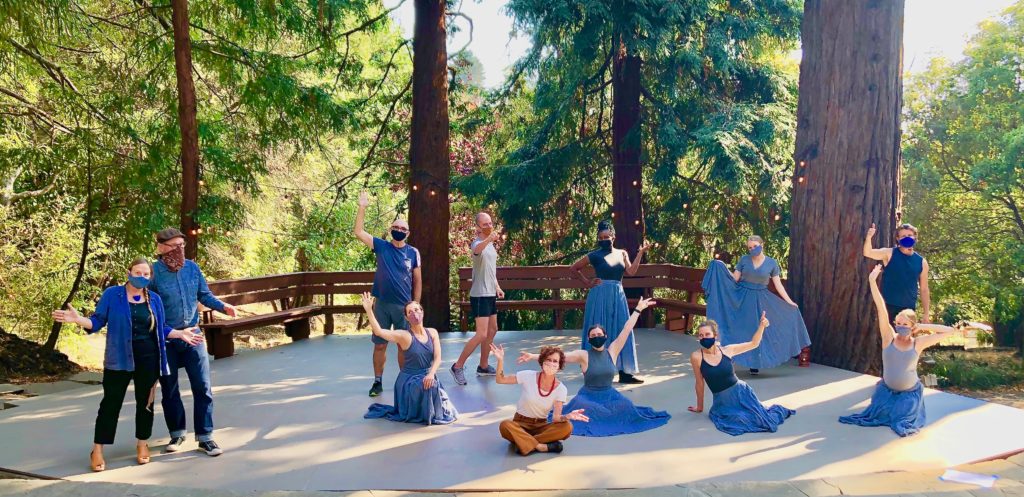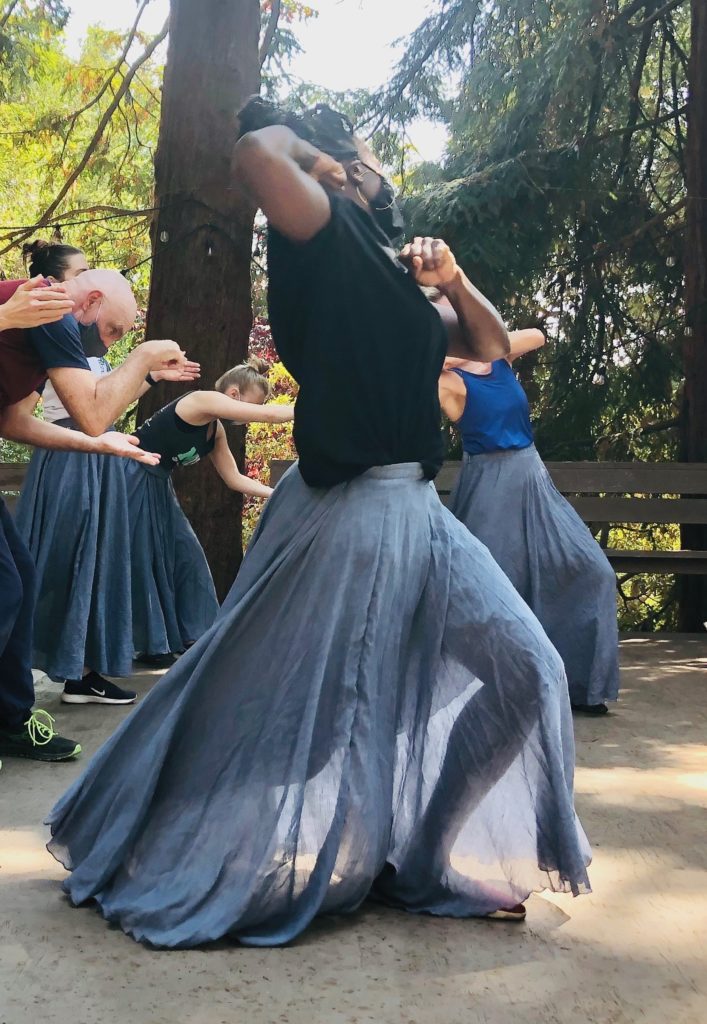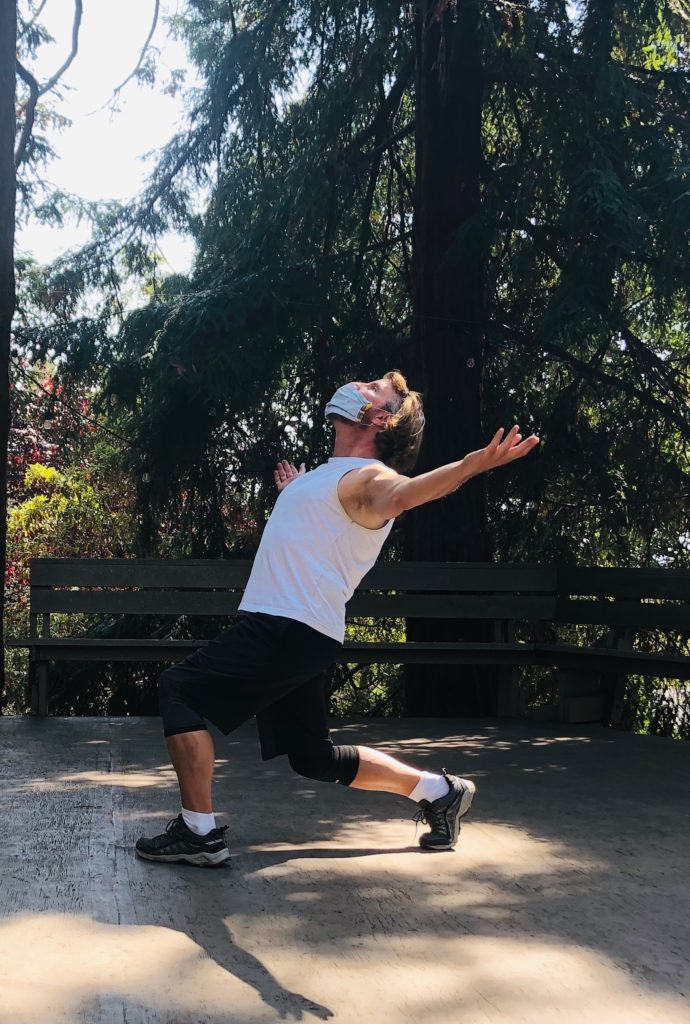
[Image description: The cast and creatives for Farallonites pose for a photo, all masked and physically distant. They are on a stage outdoors framed by large trees with a bright sky peeking through the branches. Although masked, everyone appears joyful and energized.]
One Saturday afternoon last February, I sat upstairs in Shawl-Anderson Dance Center’s large studio space watching Dana Lawton Dances (DLD) prepare their upcoming new work, The Farallonites. Created by Artistic Director Dana Lawton, scored by Thomas Edler and inspired by a set of poems by Jennifer Kulbeck, The Farallonites was slated to premiere April 24, 2020 at Fort Mason’s Cowell Theater. When I was invited to observe this particular rehearsal, the mixed discipline collaboration was well on its way. A blend of text, music, light and movement, the evening-length piece told the story of the dedicated lighthouse keepers who lived on the Farallon Islands in the 1800s – an uninhabitable archipelago twenty-seven miles off the coast of San Francisco. What follows are some initial observations I had about the work’s various chapters:
A duet called ‘birds’ finds one dancer balancing on the back of another, like a raven or eagle suspending itself on a cliff before soaring into the air. A variation for the company’s women is grounded in a collective triplet step, countered by upper bodies performing individualized task-based gestures. It has such a beautiful duality to it – the common footwork pattern suggesting a keen sense of sisterhood while the rest of the body reading of loneliness and isolation. Yet another ensemble sequence takes the form of a square dance. While uproarious in quality, it also has a tenuous overtone. Would the rigors and responsibility of their chosen life allow such revelry? Probably not. So, is this a dream? A memory? A longing? Each attendee will have to decide for themselves.[1]
One can see direct parallels with our current situation. Threads of seclusion. Quarantine. Protection. Remoteness. And underlying it all is a profound theme: individual sacrifice for the greater good. Nine months ago, Lawton explained it like this:
“In the mid-1800s, the beacon was constructed on the Farallons to protect ships from crashing into the Islands, and so a few families moved there to run the lighthouse. The conditions were so treacherous and inhospitable – supplies would only arrive every six to nine months; when outside, their children had to be tied to boulders for protection against the water, wind and fog – and yet they were willing to navigate such a reality to provide light, saving people they would never meet.”[2]
Our actions right now – mask-wearing, staying home, socially distancing – are similarly about caring. Yes, caring for ourselves and those in our homes, but equally about caring for others. And it’s hard. We don’t know how long the self-isolating will last. We want to get back to our lives. To hug our friends. To venture outside without fear of who or what we may come into contact with. To travel. To see co-workers and colleagues in three dimensions, instead of on a screen.
Little did I know, but that February day would be one of the last times I would be in a dance studio in 2020. Just a few weeks later, in mid-March, shelter-in-place would be invoked to help curb the spread of COVID-19. So many programs and events would be cancelled, The Farallonites being one of them. Ergo, the feature I was writing about it then would also not make it to an audience. Today, the coronavirus continues to rage on. The Farallonites, along with so many other projects, still awaits its debut.

[Image description: In the section called Water, two dancers downstage in long flowing skirts are in motion (we see them from the side). Behind them are other dancers leaning toward them, just in the frame.]
‘Awaits’ is a key term. The Farallonites is still very much alive, though its journey has indeed been different than originally planned. Just before Thanksgiving, I caught up with Lawton (by phone) to learn more about the work’s trajectory and how she and the DLD family have been weathering a very bizarre 2020. “When it was clear that the April show was a no-go, we had a conversation about what we wanted to do,” she relays, “the dancers were incredibly committed to continuing the rehearsal process, so starting in July, we began rehearsing outdoors, masked and socially distanced – it was really affirming and actually felt very normal, even though we were in masks and not touching one another.” They knew some sections, like solos, were doable within safety protocols, while others would need to be re-worked in light of these new conditions. At first, the notion of changing things, especially parts that had been set for some time, seemed a bit daunting, but the creative journey proved both revelatory and powerful. New artistic lenses and a deeper narrative layer began to emerge amidst the constraints. “The Farallonites is all about isolation; no one was together – needing to rehearse in the way we had to – drove this point home; we were able to discover new insights within the choreography,” describes Lawton. In the open air, they could feel the breeze and wind informing arm movements and torso undulations. They were able to take rehearsals to the beach and had the chance to see how the material changed when performed in actual water. And the duality of being together and being apart at the same time took on new meaning.

[Image description: A black and white image of two dancers, both masked. One faces the camera in a long skirt, cropped tank, and sneakers, looking toward their left front diagonal with arms gesturing in the same direction. Behind them is another dancer, clothing is dark and appears to blend into the backdrop of trees. This dancer faces away from the camera.]
A subsequent conversation with a friend led Lawton to also consider newness along another track in the rehearsal process. She suggested that Lawton’s son Henry, an avid skateboarding vlogger, might film and create vlogs of DLD as they continued building The Farallonites. Not dance film, but more a chronicle of process. While DLD has worked with video and projection in performance, this type of documentarian approach was something new for them. And they were all eager to see what might be captured. The resulting footage (available on Dana Lawton Dances’ Facebook page) is full of rich commentary and striking visuals – from choreographic phrases to conversations with the dancers to moments of discovery, experimentation and real-time trial and error. The genuineness and authenticity in every frame is undeniable, and as I watched each film, the impulse to move with the dancers was so strong.
At that point in the year (summer), a November premiere of The Farallonites at the Cowell was still a possibility. No one knew what fall might bring. But as September arrived, it became obvious that the work was not going to see a theater in 2020. For Lawton and DLD, that decision was both about safety and monetary realities: “a lower capacity, distanced audience, assuming that was even possible, just doesn’t work for our budget – we need to strive for a full house.” With traditional indoor venues off the table for the time being, The Farallonites’ fate was unclear. Suddenly, a new opportunity arose. In a Kensington backyard, amidst statuesque redwoods, a stunning, private outdoor amphitheater stood. A stage surface, lights, seating – the whole nine yards! And it belongs to Danny Scher, who is a former colleague of DLD company member Robin Nasatir. Scher graciously offered up the space, and on October 3, DLD was able to share excerpts of The Farallonites with a small live audience, while adhering to the strictest of safety protocols. “Seeing the work in a natural setting was really quite something, as was the fact that people showed up,” Lawton remembers, “it was a moment to recognize the power of community, and the intense appetite for art, while being as safe as we could possibly be.”

[Image description: Dancer in a mask, white tank top, dark shorts and sneakers lunges forward arms outstretched looking to the sky. They are standing outdoors in front of trees with light coming through the branches.]
DLD is not currently in rehearsal, though the company plans to re-group in March. The hope is by then that The Farallonites’ next step might be clearer. “With its atmosphere and immersive location on the water in Fort Mason, I still have dreams of the piece on the Cowell stage, but who knows when and if that will happen, and where all the company dancers might be at that time,” shares Lawton. It could be months; it will probably be years. Though when that moment does come, Lawton knows it’s going to epic, for The Farallonites, for the larger artistic community, and for humanity, “I don’t really know what will be the same and what will be different when this is all over, but I think we can anticipate that the desire for virtual life will greatly diminish and it will be replaced by a tremendous renaissance in and hunger for live experiences.”
[1] Excerpt is taken from an article I wrote for In Dance titled Lights That Guide: Dana Lawton Dances presents The Farallonites – it was intended to be printed as part of In Dance’s April 2020 edition, but due to COVID, The Farallonites performance was postponed.
[2] Ibid.
This article appeared in the Winter 2021 issue of In Dance.

